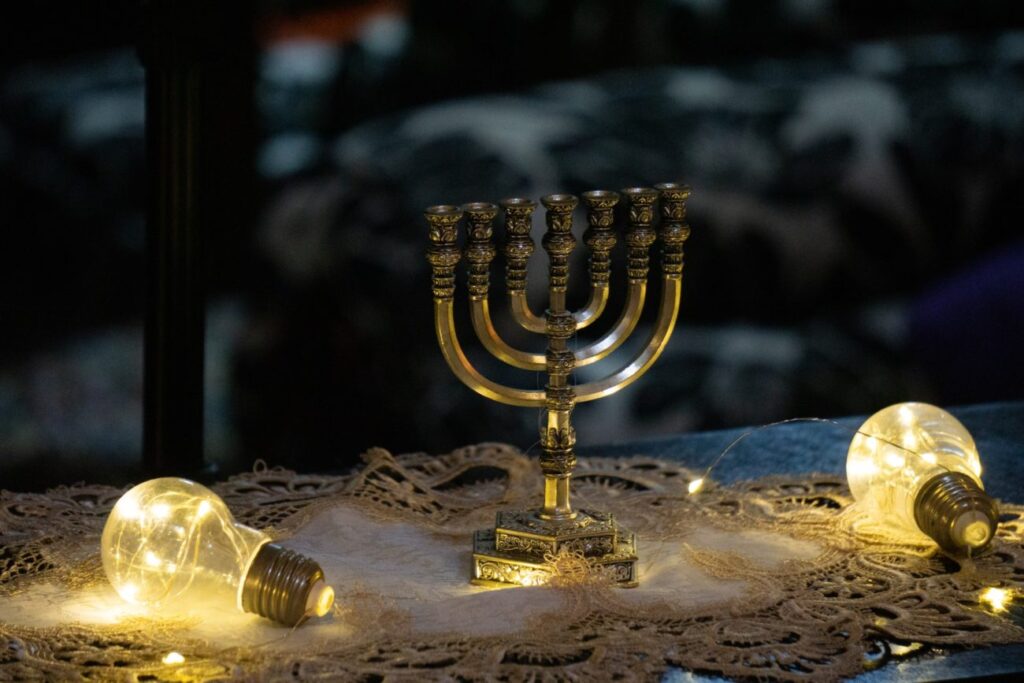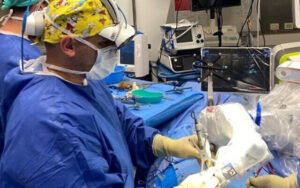
A la cinquena alià de la paraixà d’aquesta setmana, després d’informar-nos d’on es situarà l’arca del testimoni, la Torah ens diu que caldrà fer una partició, un «parohet» i el lloc on anirà. I que servirà de partició entre el kodeix-hakodaixim, on estarà l’arca, i el kodeix, la part interior del Tabernacle: «Tu penjaràs el vel sota els ganxos, i portaràs l’arca del Testimoni a la part interior de la cortina separadora de l’Arca del Testimoni, i la cortina separadora dividirà per tu entre el Sant i el Sant de Sants.» (Xemot, Èxode, 26:33).
El Ramban explica que aquest ordre en particular, penjar la cortina i després portar l’arca, no s’ha de prendre de forma literal, perquè s’està referint a la «realització» del Mixcan, del Tabernacle, i no a la seva «erecció». De mal mateixa manera, quan s’instrueix a Moisès per tal que posi «la tapa sobre l’arca del Testimoni al lloc més sagrat» (vers 34), no vol dir que només s’ha de col·locar la tapa a sobre l’Arca un cop aquesta s’ha portat a dins del lloc més sagrat, i s’ha cobert amb la cortina.
La intenció és informar a Moisès que pengi la cortina per tal que l’arca quedi allà, darrere el vel, i que el vel separi això «entre el lloc sant i el lloc més sant». I que la tapa, amb els querubins sobre l’arca, ha d’estar dins el Sant de Sants, darrere del vel (R. M. ben Nachman, Commentary to the Torah: Xemot, traduït i comentat per Charles b Chavel, p. 469).
Això canviarà quan el Sant, beneït sigui, ordeni a Moisès que construeixi físicament el Mixcan: «I tu posaràs a dins l’Arca del Testimoni», i després «tu cobriràs l’arca amb el vel» (Xemot, 40:3). I així ho farà: «i va posar la tapa de l’arca sobre l’arca. I va portar l’arca a dins del Tabernacle, i va posar el vel de separació» (Xemot 40:20-21).
És a dir, que el Sant, beneït sigui, està dient a Moisès la forma que tindrà el Mixcan, i no pas l’ordre de construcció. Estem parlant del concepte, no de l’execució. I el concepte del Mixcan, del primer lloc des d’on el Sant parlarà entre els querubim, cal explicar-lo bé. I un cop s’entén aquest concepte i estiguem situats, podrem posar la resta del mobiliari: «la taula fora de la separació, i la menorà a l’altra banda de la taula, a la part sud del Mixcàn, i posaràs la taula a la part nord.» (Xemot, èxode, 26:35).
I per què, aquesta disposició? El Mestre Sforno ens ho diu: estan allà per honor a Qui seu al tron. La menorà està a la dreta i la taula a l’esquerra, ja que està escrit «dies llargs [llarga vida] a la dreta i a l’esquerra riquesa i honor» (Mixleï, Proverbis 3:16 – (Ovadiah ben Jacob Sforno, Commentary on the Torah, traduït i comentat per Rabí Raphael Pelcovitz, p. 429).
Quan estem ben situats i veiem amb claredat tot el que hem de veure, allà on se suposa que ha d’estar, aconseguim una vida bona i llarga.
In the fifth aliah of this week’s parashah, after informing us where to place the ark of the Testimony, the Torah tells us that it will be necessary to make a partition, a “parohet”. And the place where it will go. “And you shall place the dividing curtain beneath the clasps. You shall bring there on the inner side of the dividing curtain the Ark of the Testimony, and the dividing curtain shall separate for you between the Holy and the Holy of Holies.» (Shemot, 26:33).
The Ramban, Rabbi Moses ben Nakhman from Girona, explains that this particular order, hanging the curtain and then carrying the ark, should not be taken literally. Because it is referring to the “making” of the Mishkan, the Tabernacle. Not its “erection”. In the same way, when Moses gets instructions to put “the cover upon the Ark of the Testimony in the most holy place” (verse 34), it does not mean that the cover should be placed on top only when the Ark is inside the holiest place, screened with the veil.
The intention is to inform Moses to hang the curtain so that the ark will be there, behind the veil. And that the veil will divide “between the holy place and the most holy place.” And that the ark-cover, with the cherubim on the ark, must be inside the Holy of Holies, behind the veil (Rabbi Moses ben Nachman, Commentary to the Torah: Shemot, translated and commented on by Charles b Chavel, p. 469).
This will change when the Holy One, blessed, commands Moses to physically build the Mishkan: “And thou shalt put therein the ark of the Testimony”, and then “thou shalt screen the ark with the veil” (Shemot, 40:3). And so he did: “and he put the ark-cover above the ark. And he brought the ark into the Tabernacle», and after that, “he set up the veil of the screen” (Shemot 40: 20-21).
That is, the Holy One, blessed, is telling Moses the shape of the Mixkan, not the order of construction. We are talking about the concept, not the execution. The concept of the Mixkan, the first place from which the Holy One will speak, between the cherubim, must be well explained. Once we understand this concept and we are precisely located on the inside, we can put the rest: “the table on the outer side of the dividing curtain and the menorah opposite the table, on the southern side of the Mishkan, and you shall place the table on the northern side.” (Xemot, exodus, 26:35).
And why this provision? Rabbi Sforno tells us: [the table and the menorah] they are there to honor of the One who sits on the chair. The menorah is on the right and the table on the left. As it says “length of days is in her right and in her left hand are riches and honor” (Proverbs 3:16 – Ovadiah ben Jacob Sforno, Commentary on the Torah, translated and commented on by Rabbi Raphael Pelcovitz, 429).
When we are well situated and we clearly see everything we have to see, placed where it is supposed to be, we get a good, long life.


















